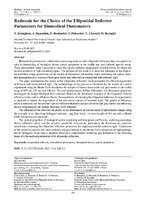| dc.contributor.author | Bezuglaya, N. | |
| dc.contributor.author | Haponiuk, A. | |
| dc.contributor.author | Bondariev, D. | |
| dc.contributor.author | Poluectov, S. | |
| dc.contributor.author | Chornyi, V. | |
| dc.contributor.author | Bezuglyi, M. | |
| dc.coverage.spatial | Минск | ru |
| dc.date.accessioned | 2021-12-21T13:09:23Z | |
| dc.date.available | 2021-12-21T13:09:23Z | |
| dc.date.issued | 2021 | |
| dc.identifier.citation | Rationale for the Choice of the Ellipsoidal Reflector Parameters for Biomedical Photometers = Обоснование выбора параметров эллипсоидальных рефлекторов биомедицинских фотометров / N. Bezuglaya [et al.] // Приборы и методы измерений. – 2021. – Т. 12, № 4. – С. 259-271. | ru |
| dc.identifier.uri | https://rep.bntu.by/handle/data/108333 | |
| dc.description.abstract | Biomedical photometersʼ information-measuring systems with ellipsoidal reflectors have acceptable results in determining of biological tissues optical properties in the visible and near-infrared spectral range. These photometers make it possible to study the optical radiation propagation in turbid media for direct and inverse problems of light-scattering optics. The purpose of this work is to study the influence of the ellipsoidal reflectors design parameters on the results of biomedical photometry when simulating the optical radiation propagation in a system of biological tissue and reflectors in transmitted and reflected light. The paper substantiates the choice of the ellipsoidal reflectors’ focal parameter for efficient registration of forward and backscattered light. The methodology of the process is illustrated by the results of a model experiment using the Monte Carlo simulation for samples of human brain white and gray matter at the visible range of 405 nm, 532 nm, and 650 nm. The total transmittance, diffuse reflectance, and absorption graphs depending on the sample thickness were obtained. Based on the introduced concepts of the ellipsoidal reflector efficiency index and its efficiency factor, the expediency of choosing the ellipsoidal reflectors focal parameter is analyzed to ensure the registration of the maximum amount of scattered light. The graphs of efficiency index in reflected and transmitted light for different thickness samples of white and gray matter and efficiency factors depending on the sample thickness were obtained. The influence of the reflectors ellipticity on the illuminance of various zones of photometric images using the example of an absorbing biological medium – pig liver tissue – at wavelength of 405 nm with a Monte Carlo simulation was analyzed. The optical properties of biological media (scattering and absorption coefficients, scattering anisotropy factor, refractive index) and the samples’ geometric dimensions, particularly the thickness, are predetermined when choosing the ellipsoidal reflectors parameters for registration of the scattered light. Coordinates of the output of photons and their statistical weight obtained in the Monte Carlo simulation of light propagation in biological tissue have a physical effect on a characteristic scattering spot formation in the receiving plane of a biomedical photometer with ellipsoidal reflectors. | ru |
| dc.language.iso | en | ru |
| dc.publisher | БНТУ | ru |
| dc.title | Rationale for the Choice of the Ellipsoidal Reflector Parameters for Biomedical Photometers | ru |
| dc.title.alternative | Обоснование выбора параметров эллипсоидальных рефлекторов биомедицинских фотометров | ru |
| dc.type | Article | ru |
| dc.identifier.doi | 10.21122/2220-9506-2021-12-4-259-271 | |
| local.description.annotation | Информационно-измерительные системы биомедицинских фотометров с эллипсоидальными рефлекторами показали приемлемые результаты при определении оптических свойств биологических тканей в видимом и ближнем инфракрасном спектральном диапазоне. Такие фотометры позволяют исследовать распространение оптического излучения в мутных средах при прямой и инверсной задачах оптики светорассеяния. Целью данной работы являлось исследование влияния конструктивных параметров эллипсоидальных рефлекторов на результаты биомедицинской фотометрии при симуляции распространения оптического излучения в системе биологической ткани и рефлекторов. В работе обоснован выбор фокального параметра эллипсоидальных рефлекторов для эффективной регистрации рассеянного вперёд и назад света. Методика процесса проиллюстрирована результатами модельного эксперимента при использовании метода Монте-Карло для образцов белого и серого вещества мозга человека на длинах волн видимого диапазона 405 нм, 532 нм и 650 нм. Получены графики зависимости полного пропускания, диффузного отражения и поглощения в зависимости от толщины исследуемого образца. На основе введённых понятий показателя эффективности и коэффициента эффективности проанализирована целесообразность выбора фокального параметра эллипсоидальных рефлекторов для обеспечения регистрации максимального количества рассеянного света. Получены графики показателей эффективности в отражённом и прошедшем свете для разнотолщинных образцов белого и серого веществ, а также коэффициентов эффективности в зависимости от толщины образца. Проанализировано влияние эллиптичности рефлекторов на освещённость различных зон фотометрических изображений на примере поглощающей биологической среды – ткани печени свиньи – на длине волны 405 нм при симуляции Монте-Карло. Оптические свойства биологических сред (коэффициенты рассеяния и поглощения, коэффициент анизотропии рассеяния, показатель преломления) и геометрические размеры образцов, в частности толщина, предопределяют выбор параметров эллипсоидальных рефлекторов для регистрации рассеянного света. Координаты выхода фотонов и их статистический вес, полученные при моделировании распространения света в биологической ткани методом Монте-Карло, оказывают физическое влияние на формирование характерного пятна рассеяния в приёмной плоскости биомедицинского фотометра. | ru |

